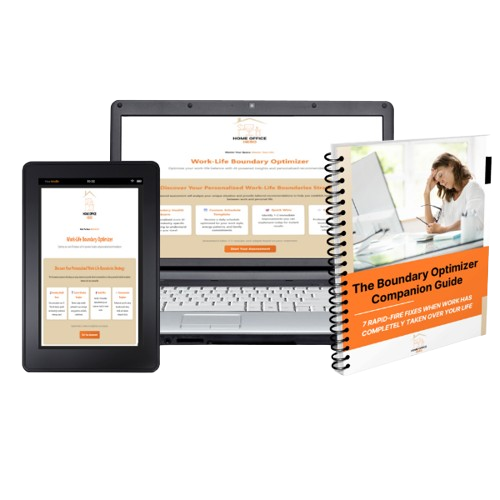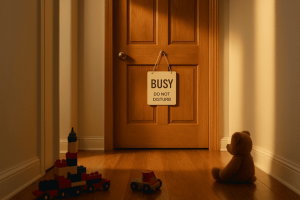Friday night. 7:30 PM. Sacred family movie night—the one non-negotiable block I’d fought to protect.
We were twenty minutes into the film, Shaw nestled between me and Hayley with his bowl of popcorn, when my phone lit up. A client. “Need urgent website changes before Monday morning presentation.”
I felt my chest tighten. This was exactly why I’d created these rigid boundaries. Work time and family time were supposed to be separate. I’d worked all day. Now it was family time. The rules were clear.
But here’s the problem: my business doesn’t care about my rules. My clients don’t operate on my schedule. And sitting there in the dark, ignoring that message while anxiety built in my stomach, I realized something.
I wasn’t protecting family time. I was just creating a different kind of stress.
That night, sitting in the glow of the TV trying to decide between disappointing my client or disrupting family time, I finally understood: the problem wasn’t that I was bad at balance. The problem was that balance itself—this idea of keeping work and family in separate, airtight boxes—was impossible for remote working parents.
This is part of our complete guide on work-life balance for remote working parents, and in this post, I’m going to share why work life integration might be the answer you’ve been searching for. Not another productivity hack or time management trick—a complete reframe of how work and family can coexist without constant conflict.
If you’re exhausted from trying to maintain rigid separation between work and family, this post will show you there’s another way.
The Problem With Balance
We’ve all heard the work-life balance advice: “Leave work at work.” “Be fully present at home.” “Create clear boundaries between professional and personal.”
Brilliant advice. Completely useless for remote working parents.
When your office is your dining table and your colleagues are video call away during dinner time, there’s no physical separation between work and home. The lines don’t just blur—they disappear entirely. You’re answering client emails while your kids eat breakfast. You’re on Zoom calls during school pickups. You’re thinking about that project deadline while reading bedtime stories.
For six years running my digital marketing agency from home, I kept trying to achieve balance. I’d set strict work hours, then break them when a client emergency hit. I’d promise myself “no work after 6 PM,” then sneak back to my laptop after Shaw went to bed. The guilt was constant. When I was working, I felt guilty about not being with family. When I was with family, I worried about falling behind on work.
The traditional work-life balance model assumes work and life are opposing forces that need to be kept separate and equal. But here’s what that approach actually creates for remote working parents: exhaustion, guilt, and the feeling of constantly disappointing someone.

Why Integration Beats Balance
Integration isn’t about working more or letting work consume your life. It’s about creating a sustainable rhythm where work and family coexist without conflict.
Think about it this way: In rugby, I learned that the best teams don’t rigidly separate positions—they flow together. The forwards support the backs. The backs cover for the forwards. Everyone adapts based on what the game demands. That’s integration.
Work-life integration means:
- Taking a work call while walking your kid to school
- Doing the school run in the middle of your workday, then returning to deep work later
- Including your children in age-appropriate aspects of your work
- Being honest with clients about your family commitments
- Structuring your work around your energy and family rhythms, not arbitrary 9-5 hours
The difference isn’t semantic. Balance implies a zero-sum game: more time with family means less time for work. Integration recognizes that some activities can serve both. When you understand how to design your ideal day around integration rather than separation, everything shifts.
The Integration Framework
After years of trial and error—including that movie night when I realized rigid separation was creating more stress than solutions—I developed a framework that actually works:
1. Energy-First Scheduling
Instead of forcing yourself into traditional work hours, map your energy throughout the day. When are you sharpest? When do your kids need you most? Build your schedule around these realities.
For me, that meant abandoning the 9-5 pretense entirely. I do my best strategic work between 5:30-7:30 AM before Shaw wakes up. I’m fully present for morning routine and school drop-off. I work in focused blocks during school hours. I’m off by 3:30 PM for pickup and family time. If needed, I’ll do admin tasks after 8 PM when my energy for deep work is shot anyway.
2. Transparent Communication
Integration requires honesty with everyone. I tell clients I’m a dad with school commitments. I tell my family when work genuinely needs my focus. Setting work from home boundaries isn’t about building walls—it’s about creating windows of flexibility that everyone understands.
One of my clients once emailed at 9 PM, frustrated I hadn’t responded immediately. I explained my working hours and family commitments. He appreciated the clarity and we adjusted expectations. He knew exactly when to expect responses, and I stopped feeling guilty about not being available 24/7.
3. Flexible Presence
This might sound contradictory, but integration means being more present—just not simultaneously for everything. When I’m working, I’m actually working (not half-working while feeling guilty). When I’m with Shaw, I’m actually with him (not checking email every five minutes).
The secret? Three “anchor points” in my day where I transition fully: Morning family time, midday reset (quick walk or coffee break), and evening shutdown ritual. These bookend my work and help me shift mindsets.
4. Strategic Overlap
Some activities can serve both work and family. I’ve taken Shaw to client meetings (when appropriate). He’s seen me recording videos and now creates his own. We talk about problem-solving and persistence—concepts from my business that teach him life skills.
This isn’t about making your kids part of your workforce. It’s about not hiding your work life from your family life as if they’re shameful secrets.
[IMAGE 3: Parent working at desk with child doing homework nearby, both focused on their tasks. Alt text: “Parent and child working independently side by side showing healthy work-life integration”]
Real-World Integration in Action
Let me show you what this looks like in practice:
Scenario 1: The School Call Old balance approach: Panic. Reschedule the meeting. Feel guilty for both work and school. Integration approach: “I need to step away for 30 minutes for my son’s school. Can we continue after lunch?” Most people respect this. Those who don’t aren’t the right clients anyway.
Scenario 2: The Deadline Crunch Old balance approach: Work until midnight after kids sleep. Be exhausted the next day. Resent both work and family. Integration approach: Communicate honestly with family. “I need three hours of focused work Saturday morning. Then I’m fully present for our afternoon plans.” Get help or trade childcare time with your partner.
Scenario 3: The Unexpected School Day Off Old balance approach: Stress about lost work time. Try to work while kids are bored and disruptive. Integration approach: Adjust the day. Maybe the morning becomes family time and you work evening hours. Or you set kids up with an activity and work in shorter bursts with planned breaks.
The key difference? Integration removes the guilt because you’re not failing at balance—you’re succeeding at adaptation.oices. You’re not failing at balance when things go wrong—you’re adjusting your systems based on new information.
Implementing Integration: Your 7-Day Start
You don’t overhaul your entire life overnight. Here’s how to begin:
Day 1-2: Energy Audit Track your energy levels every two hours. Note when you’re sharpest, when you’re depleted, when kids need you most. Don’t change anything yet—just observe.
Day 3-4: Identify Integration Opportunities Where can work and family coexist without conflict? Maybe you take calls while walking. Maybe you involve kids in simple work tasks. Find three opportunities.
Day 5-6: Set Three Anchor Points Choose three non-negotiable transition moments in your day. Morning connection time, midday reset, evening shutdown. These become your integration boundaries.
Day 7: Communicate Your Integration Plan Tell your family what you’re trying. Tell key clients about your working rhythm. Clarity prevents disappointment. Building effective work-life boundaries for remote working parents means everyone knows what to expect.
Expect resistance. Your clients might not understand immediately. Your kids will still interrupt. You’ll slip back into old patterns. That’s normal. Integration is a practice, not a destination.bsent 90% of the time to being mentally present 70% of the time. That’s a massive, life-changing improvement.
Measuring IntegrationSuccess
Forget productivity metrics. Integration success looks different:
- You feel less guilty when working during family time because you’ve communicated your schedule
- Your kids understand when you’re available and when you need focus
- Clients respect your boundaries because you’ve set clear expectations
- You’re actually present in both work and family moments instead of mentally divided
- Your energy improves because you’re working with your natural rhythms instead of against them
Track these questions weekly:
- How often did I feel torn between work and family this week?
- Did I have moments of genuine presence in both areas?
- Do the people in my life (family and clients) understand my availability?
If you’re moving toward “yes” on these, integration is working.
Conclusion
Work-life balance assumes work and life are opposing forces fighting for your time. Work-life integration recognizes they’re both parts of your life that can coexist without constant conflict.
You don’t need to choose between being a present parent and a successful professional. You need to stop trying to keep them in separate boxes and start building a rhythm that honors both.
Key Takeaways:
- Balance creates guilt by positioning work and family as competitors
- Integration allows work and family to coexist through honest communication and flexible presence
- Energy-first scheduling beats arbitrary work hours for remote parents
- Three daily anchor points help you transition between work and family mindsets
- Success means less guilt and more genuine presence—not perfect separation
Your Next Step: Do the 7-day energy audit starting tomorrow. Just observe—don’t change anything yet. Understanding your natural rhythms is the foundation of integration.
Over to you: What’s one way you could integrate work and family tomorrow instead of trying to balance them? Drop a comment below—I’d love to hear your ideas.y one, and sometimes the best solutions come from the community.
Continue Reading
Want to go deeper into creating sustainable work-from-home systems? Check out these related articles:
- [Work-Life Balance for Remote Working Parents: The Complete 2025 Guide to Harmony (Not Perfection)] – Our comprehensive guide covering all aspects of work-life harmony for remote working parents
- [Work From Home Parent Schedule: How to Design Your Ideal Day] – Learn how to create an energy-first schedule that works for your family
- [Work From Home Boundaries: Setting Limits Without Guilt] – Master the art of setting boundaries that protect both your work and family time
Part of the Work-Life Balance & Harmony series. For the complete guide, see our [Work-Life Balance for Remote Working Parents: The Complete 2025 Guide to Harmony (Not Perfection)].










